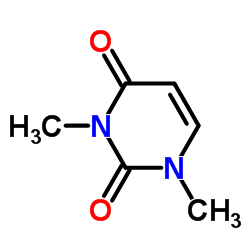Fenton chemistry of 1,3-dimethyluracil.
J A Theruvathu, C T Aravindakumar, R Flyunt, J von Sonntag, C von Sonntag
Index: J. Am. Chem. Soc. 123(37) , 9007-14, (2001)
Full Text: HTML
Abstract
Hydroxyl radicals were generated in the Fenton reaction at pH 4 (Fe(2+) + H(2)O(2) --> Fe(3+) + .OH + OH-, k approximately equal to 60 L mol(-1) s(-1)) and by pulse radiolysis (for the determination of kinetic data). They react rapidly with 1,3-dimethyluracil, 1,3-DMU (k = 6 x 10(9) L mol(-1) s(-1)). With H(2)O(2) in excess and in the absence of O(2), 1,3-DMU consumption is 3.3 mol per mol Fe(2+). 1,3-DMUglycol is the major product (2.95 mol per mol Fe(2+)). Dimers, prominent products of .OH-induced reactions in the absence of Fe(2+)/Fe(3+) (Al-Sheikhly, M.; von Sonntag, C. Z. Naturforsch. 1983, 31b, 1622) are not formed. Addition of .OH to the C(5)-C(6) double bond of 1,3-DMU yields reducing C(6)-yl 1 and oxidizing C(5)-yl radicals 2 in a 4:1 ratio. The yield of reducing radicals was determined with tetranitromethane by following the buildup of nitroform anion. Reaction of 1 with Fe(3+) that builds up during the reaction or with H(2)O(2) gives rise to a short-chain reaction that is terminated by the reaction of Fe(2+) with 2, which re-forms 1,3-DMU. In the presence of O(2), 1.1 mol of 1,3-DMU and 0.6 mol of O(2) are consumed per mol Fe(2+) while 0.16 mol of 1,3-DMU-glycol and 0.17 mol of organic hydroperoxides (besides further unidentified products) are formed. In the presence of O(2), 1 and 2 are rapidly converted into the corresponding peroxyl radicals (k = 9.1 x 10(8) L mol(-1) s(-1)). Their bimolecular decay (2k = 1.1 x 10(9) L mol(-1) s(-1)) yields approximately 22% HO(2)./O(2).(-) in the course of fragmentation reactions involving the C(5)-C(6) bond. Reduction of Fe(3+) by O(2).(-) leads to an increase in .OH production that is partially offset by a consumption of Fe(2+) in its reaction with the peroxyl radicals (formation of organic hydroperoxides, k approximately 3 x 10(5) L mol(-1) s(-1); value derived by computer simulation).
Related Compounds
| Structure | Name/CAS No. | Molecular Formula | Articles |
|---|---|---|---|
 |
1,3-Dimethyluracil
CAS:874-14-6 |
C6H8N2O2 |
|
Excited state structures and decay dynamics of 1,3-dimethylu...
2013-10-03 [J. Phys. Chem. B 117(39) , 11660-9, (2013)] |
|
Ionization of dimethyluracil dimers leads to facile proton t...
2012-04-01 [Nature Chemistry 4(4) , 323-9, (2012)] |
|
The SO4(.-)-induced chain reaction of 1,3-dimethyluracil wit...
1987-03-01 [Int. J. Radiat. Biol. Relat. Stud. Phys. Chem. Med. 51(3) , 441-53, (1987)] |
|
Equilibrium of formation of the 6-carbanion of UMP, a potent...
2002-11-27 [J. Am. Chem. Soc. 124(47) , 13986-7, (2002)] |
|
Probing noncovalent interactions in biomolecular crystals wi...
2008-03-14 [ChemPhysChem 9(4) , 544-7, (2008)] |